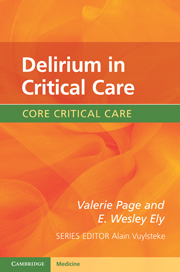Book contents
- Frontmatter
- Contents
- Foreword
- Delirium, a patient testimony
- 1 What is delirium in critical care?
- 2 How common is delirium in critical care?
- 3 What does delirium look like in critical care?
- 4 Delirium in critical care: how does it happen?
- 5 Delirium: what causes it? Risk factors
- 6 Delirium in critical care: why is it important?
- 7 Delirium in critical care: how do we diagnose it?
- 8 How to prevent delirium?
- 9 Treatment of delirium in critical care
- 10 Mental capacity and restraints
- 11 End-of-life care
- 12 What is the future?
- Selected references
- Index
- References
4 - Delirium in critical care: how does it happen?
Published online by Cambridge University Press: 05 December 2011
- Frontmatter
- Contents
- Foreword
- Delirium, a patient testimony
- 1 What is delirium in critical care?
- 2 How common is delirium in critical care?
- 3 What does delirium look like in critical care?
- 4 Delirium in critical care: how does it happen?
- 5 Delirium: what causes it? Risk factors
- 6 Delirium in critical care: why is it important?
- 7 Delirium in critical care: how do we diagnose it?
- 8 How to prevent delirium?
- 9 Treatment of delirium in critical care
- 10 Mental capacity and restraints
- 11 End-of-life care
- 12 What is the future?
- Selected references
- Index
- References
Summary
Questions with no answers
This chapter is a summary of what is known or suspected about the pathophysiology of delirium. What actually goes on in the brain? How does this explain the symptoms of delirium? And, importantly, how does the mechanism of delirium account for the adverse outcomes?
All good questions. Unfortunately we still do not have the answers.
The pathophysiology of delirium continues to be poorly understood. Reading about delirium pathophysiology leaves the reader frustrated, not knowing what is real, or important or the result of another process.
A number of theories have emerged, including cell membrane stability; oxygen supply and utilization; imbalance of one, two or many neurotransmitters; false transmitters; stress hormones; cytokines; inflammation; blood supply; functional connection disruption; thalamic dysfunction and quite a few more…
Some or all might be true, or linked to the truth. Given the nature of delirium it is likely that several mechanisms contribute to its development in patients.
Start at the end, final common pathway?
Delirium is thought to represent a generalized dysfunction of higher cerebral cortical processes. Not all areas of the brain, however, are equally impaired. Because of its multifactorial nature, it is thought that delirium from different causes may have different mechanisms and/or involve different parts of the brain. A final common neural pathway is likely involved in the core symptoms.
- Type
- Chapter
- Information
- Delirium in Critical Care , pp. 45 - 67Publisher: Cambridge University PressPrint publication year: 2011

